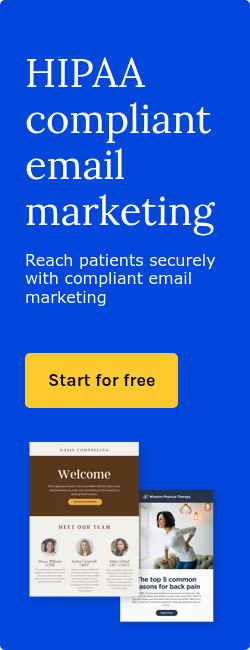
Communicating with your patients via email is one of the best ways to keep them engaged in your brand. But how do you know if that’s true for your practice? How do you measure the effectiveness of your patient email campaigns and get the most out of your efforts?
Key performance indicators (KPIs) are a good way to start. (KPIs) are quantifiable measures that help businesses evaluate their progress toward achieving important objectives. KPIs help you understand how your email campaign performs. Many email marketing platforms track KPIs and create reports summarizing the data. These reports make it easy to compare data against your past emails and against industry email marketing statistics.
Once you understand how your emails perform, you can build upon what is working, change what doesn’t, and create patient engagement strategies around your metrics.
What KPIs are most meaningful to your business?
Open rate: Compares the number of emails opened against the total number of emails delivered. Personalized and compelling subject lines are the number one way to increase your open rate.
Click rate: Percentage of total recipients who clicked a link in the email. Reports can tell you how many contacts and who clicked a link.
Conversion rate: Percentage of contacts who perform the action you want them to take. What counts as a conversion depends on what your goals are, but common examples are scheduled appointments, completed patient forms, and signing up as a customer.
Bounces: Bounces occur when an email server rejects an email. A low bounce rate gives you a good sender reputation. A high bounce rate means your content is going undelivered and unseen. There are two types of bounces. A hard bounce email can’t be delivered for a permanent reason, like the email doesn’t exist. A soft bounce is a temporary issue like a full inbox.
Unsubscribes: Contacts who have opted out of your audience. Peaks in your unsubscribe rate could indicate a bigger issue, like poor subject lines or content your readers are not interested in.
No matter what KPIs you report on, they’re useless if you don’t listen to the data. KPIs are a powerful tool that can improve all aspects of an email campaign if put into effect.
Related: Improve patient outcomes with HIPAA compliant email marketing
Benchmarking campaign effectiveness
Benchmarking your email performance is a great way to measure your campaign effectiveness. Establishing a baseline shows you where your emails are now and determines the success of each email in the future.
Here are five benchmarks you can examine to create a baseline for your reports.
Chart past campaigns: Reviewing past email reports and charting important KPIs can tell you how your emails do month by month and can give you a good idea of how your emails should be performing.
Establish averages: Next, you can calculate the average of each metric you charted.
Identify outliers: If you had any unusually low or high metrics, take note. You can even leave them out of your average, so the number isn’t skewed one way or another.
Identify patterns: Are there any patterns in the data? Did a certain topic do well? Or does sending at a particular time have any effect on the metrics?
Set goals: With these numbers in mind, you can set goals for future emails. Benchmarketing your emails enables you to better judge the likely hood of each goal.
Improve email campaigns
Once you have your benchmark metrics, you should have a good idea of what future data should look like. But what happens if you want to improve your metrics? How do you go about improving your email campaigns?
Time: The time of day and day of the week can have a lot to do with open rates. It’s good to note that sending your emails during the early mourning, lunch hour and after work are the worst times to send them because that is when people are most likely going through their inboxes and deleting all the clutter quickly. Off-hours give your emails a better chance of being seen. It’s always good to experiment with send times until you find the one that fits your audience.
Topic: The content you provide in an email is absolutely the most important factor when determining open rates, click-through rates, and unsubscribes. Be sure to include content that is interesting, important, and informative. If your readers don’t find your emails relevant to them, they will unsubscribe.
Subject line: Subject lines are the first thing your contact is going to see once you send your email. Experiment with catchy and captivating lines that catch the audience’s eyes. There are two main types of subject lines.
Direct: Direct and to the point. Focus on the benefit your patients will receive by opening the email.
Curiosity: Tells you just enough to make you curious. These lines entice the reader to open the email to learn more.
Link anchor text: To improve click-through rates, experiment with the number and type of links you add to an email. Adding too many links may overwhelm your readers, but having too few makes you miss opportunities for more clicks and conversions.
Having a strong call to action will also trigger a psychological response in your readers. Experiment with power words and compelling text.
Layout and format: If your layout is hard to follow and uneasy to read, your audience won’t read on. A few ways you can do this are:
- Plain text vs. HTML: With HTML, emails are formatted, and images are added. Plain text has no images or formatting, like bolds, italics, and underlines.
- Text only vs. images: Text-only emails may provide a lot of information, but it equals a lot of scrolling for the reader. Too many images may leave less room for copy and not give the reader the information necessary.
- Length of email: Your readers might not reach the bottom of your email if it’s too long. And a short email won’t contain all the messages you need to relay to your audience.
You won’t know what works for your audience without a bit of experimenting. Finding out what works may take time, but in the end, you’ll be happy with the results.
Subscribe to Paubox Weekly
Every Friday we'll bring you the most important news from Paubox. Our aim is to make you smarter, faster.




